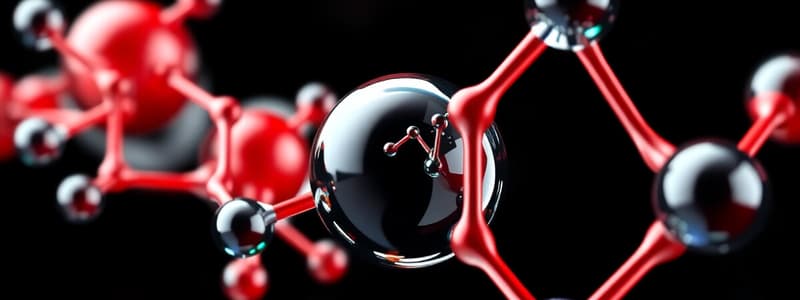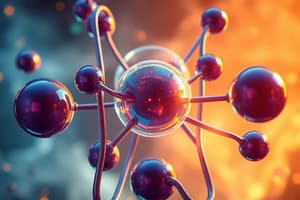Podcast
Questions and Answers
What is the significance of molar mass in chemical reactions?
What is the significance of molar mass in chemical reactions?
Molar mass is crucial for converting between the number of moles and mass of a substance, allowing for stoichiometric calculations in reactions.
Describe the difference between endothermic and exothermic reactions.
Describe the difference between endothermic and exothermic reactions.
Endothermic reactions absorb heat from the surroundings, while exothermic reactions release heat into the surroundings.
What role do catalysts play in chemical kinetics?
What role do catalysts play in chemical kinetics?
Catalysts speed up the reaction rate without being consumed, by providing an alternative pathway with lower activation energy.
How does Le Chatelier's Principle apply to a system at dynamic equilibrium?
How does Le Chatelier's Principle apply to a system at dynamic equilibrium?
What are isomers, and why are they important in organic chemistry?
What are isomers, and why are they important in organic chemistry?
What defines an element and how is it different from a compound?
What defines an element and how is it different from a compound?
Describe the characteristics of solids, liquids, and gases in terms of particle arrangement and movement.
Describe the characteristics of solids, liquids, and gases in terms of particle arrangement and movement.
What is the relationship between reactants and products in a chemical reaction?
What is the relationship between reactants and products in a chemical reaction?
Explain the difference between ionic and covalent bonds.
Explain the difference between ionic and covalent bonds.
How do groups and periods in the periodic table differ?
How do groups and periods in the periodic table differ?
What do acids and bases do in terms of protons in a chemical solution?
What do acids and bases do in terms of protons in a chemical solution?
Define what a mole is in the context of chemistry.
Define what a mole is in the context of chemistry.
What is combustion, and what are the general products of this type of reaction?
What is combustion, and what are the general products of this type of reaction?
Study Notes
Basic Concepts in Chemistry
- Atoms: The basic unit of matter, consisting of protons, neutrons, and electrons.
- Molecules: Two or more atoms bonded together.
- Elements: Substances that cannot be broken down into simpler substances; defined by the number of protons (atomic number).
- Compounds: Substances formed from two or more different elements that are chemically bonded.
States of Matter
- Solid: Definite shape and volume; particles are closely packed.
- Liquid: Definite volume but takes the shape of its container; particles are less tightly packed.
- Gas: No definite shape or volume; particles are far apart and move freely.
- Plasma: Ionized gas with free-moving ions and electrons; found in stars, including the sun.
Chemical Bonds
- Ionic Bonds: Formed when electrons are transferred from one atom to another, resulting in charged ions.
- Covalent Bonds: Formed when two atoms share electrons.
- Metallic Bonds: Delocalized electrons shared among a lattice of metal atoms.
Chemical Reactions
- Reactants: Substances that undergo a change in a chemical reaction.
- Products: Substances formed as a result of a chemical reaction.
- Types of Reactions:
- Synthesis: Two or more substances combine to form one.
- Decomposition: A single substance breaks down into two or more products.
- Single Replacement: An element replaces another in a compound.
- Double Replacement: The exchange of ions between two compounds.
- Combustion: A substance combines with oxygen, releasing energy.
The Periodic Table
- Groups: Vertical columns that categorize elements with similar properties.
- Periods: Horizontal rows that indicate the energy levels of electrons.
- Metals: Good conductors of heat and electricity; malleable and ductile.
- Nonmetals: Poor conductors; can be gases, liquids, or solids at room temperature.
- Metalloids: Exhibit properties of both metals and nonmetals.
Acids and Bases
- Acids: Substances that donate protons (H+) in solution; taste sour, turn litmus red.
- Bases: Substances that accept protons; taste bitter, feel slippery, turn litmus blue.
- pH Scale: Measures the acidity or basicity of a solution (0-14 scale; 7 is neutral).
Stoichiometry
- Mole: The amount of substance containing as many entities (atoms, molecules) as there are in 12 grams of carbon-12.
- Molar Mass: The mass of one mole of a substance, expressed in grams per mole.
- Balancing Equations: Ensures that the number of atoms for each element is the same on both sides of the equation.
Thermochemistry
- Endothermic Reactions: Absorb heat from the surroundings.
- Exothermic Reactions: Release heat to the surroundings.
- Enthalpy (ΔH): A measure of the total energy of a thermodynamic system.
Chemical Kinetics
- Reaction Rate: The speed at which reactants are converted into products.
- Factors Affecting Rate:
- Concentration of reactants
- Temperature
- Surface area of reactants
- Presence of catalysts
Chemical Equilibrium
- Dynamic Equilibrium: The state where the forward and reverse reactions occur at the same rate.
- Le Chatelier's Principle: When a system at equilibrium is disturbed, it will adjust to counteract the disturbance and restore equilibrium.
Organic Chemistry
- Hydrocarbons: Organic compounds made of hydrogen and carbon.
- Functional Groups: Specific groups of atoms that determine the characteristics and reactions of organic compounds (e.g., hydroxyl, carboxyl, amino).
- Isomers: Compounds with the same molecular formula but different structures.
Inorganic Chemistry
- Coordination Compounds: Complexes formed by metal ions bonded to ligands.
- Transition Metals: Elements found in the d-block of the periodic table; known for forming colored compounds and variable oxidation states.
Basic Concepts in Chemistry
- Atoms are the fundamental building blocks of matter comprising protons, neutrons, and electrons.
- Molecules consist of two or more atoms bonded chemically together.
- Elements are pure substances defined by their atomic number, which reflects the number of protons they contain.
- Compounds are substances created from two or more different elements bonded chemically.
States of Matter
- Solids have a fixed shape and volume with tightly packed particles.
- Liquids have a definite volume but take the shape of their container due to less tightly packed particles.
- Gases have no fixed shape or volume; their particles are far apart and move freely.
- Plasma is an ionized gas found in stars, characterized by free-moving ions and electrons.
Chemical Bonds
- Ionic bonds involve the transfer of electrons from one atom to another, culminating in the formation of charged ions.
- Covalent bonds occur when two atoms share electrons, creating a mutual bond.
- Metallic bonds allow for delocalized electrons that are shared among a lattice of metal atoms, providing conductivity.
Chemical Reactions
- Reactants are the substances that undergo transformation during a chemical reaction.
- Products are the substances generated by the reaction.
- Chemical reactions can be categorized into:
- Synthesis (combining multiple substances into one)
- Decomposition (breaking a single substance into several products)
- Single Replacement (an element substitutes another in a compound)
- Double Replacement (the exchange of ions between two compounds)
- Combustion (a substance reacts with oxygen to release energy).
The Periodic Table
- Groups are vertical columns of the periodic table that group elements with similar properties.
- Periods are horizontal rows that signify the energy levels of the elements' electrons.
- Metals are characterized as good conductors of heat and electricity, and they are malleable and ductile.
- Nonmetals are poor conductors and can exist as gases, liquids, or solids at room temperature.
- Metalloids possess a mix of properties from both metals and nonmetals.
Acids and Bases
- Acids are substances that release protons (H+) in solution, imparting a sour taste and turning litmus paper red.
- Bases accept protons, typically taste bitter, feel slippery, and turn litmus paper blue.
- The pH scale quantifies solution acidity or basicity, ranging from 0 (acidic) to 14 (basic), with 7 being neutral.
Stoichiometry
- A mole represents a specific amount of a substance, equal to 6.022 x 10^23 entities (Avogadro's number).
- Molar mass refers to the mass of one mole of a substance, measured in grams per mole.
- Balancing equations ensures equality in the number of atoms for each element on both sides of a chemical reaction.
Thermochemistry
- Endothermic reactions absorb heat from their surroundings, leading to a decrease in temperature of the surrounding environment.
- Exothermic reactions release heat, increasing the temperature of the surroundings.
- Enthalpy (ΔH) is a measure of the total energy contained within a thermodynamic system.
Chemical Kinetics
- Reaction rates indicate how quickly reactants are transformed into products.
- Factors influencing reaction rates include the concentration of reactants, temperature, surface area, and the presence of catalysts.
Chemical Equilibrium
- Dynamic equilibrium occurs when the rate of the forward reaction equals the rate of the reverse reaction, maintaining a stable concentration of reactants and products.
- Le Chatelier's Principle states that if an equilibrium system is disrupted, it will adjust to counteract the disturbance, restoring balance.
Organic Chemistry
- Hydrocarbons are organic compounds comprising only hydrogen and carbon atoms.
- Functional groups dictate the properties and reactivity of organic compounds, such as hydroxyl and carboxyl groups.
- Isomers are compounds with identical molecular formulas but differing structural configurations.
Inorganic Chemistry
- Coordination compounds consist of metal ions bonded to various ligands, forming complex structures.
- Transition metals, residing in the d-block of the periodic table, are noted for their ability to form colorful compounds and exhibit variable oxidation states.
Studying That Suits You
Use AI to generate personalized quizzes and flashcards to suit your learning preferences.
Description
Test your knowledge of fundamental chemistry concepts, including the structure of atoms, types of molecules, and states of matter. This quiz covers various aspects of chemical bonds and how different substances interact. Perfect for students and chemistry enthusiasts alike!




